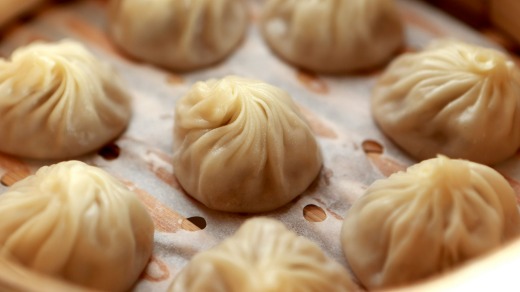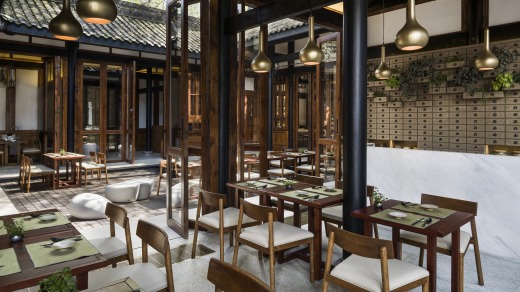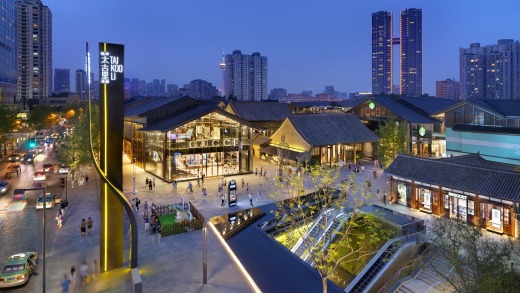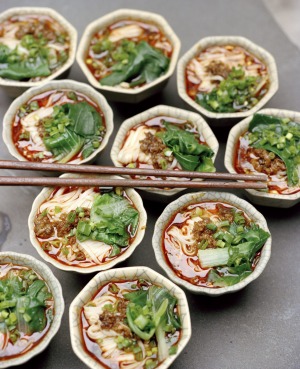
It is odd that in Chengdu, a city in central China known for its Sichuan peppercorns, hot chillies and snacks including rabbit heads and pig snouts on sticks, I am biting into an Anzac biscuit – possibly the best I have ever tasted. Also on my plate are two warm lamingtons, freshly dipped in chocolate and smothered in desiccated coconut.
"They're actually catching on in Chengdu. The other day I saw some green tea-flavoured lamos in a local bakery," Darren Greenwood, the executive chef of Temple House, a new luxury boutique hotel, says.
Yes, he called them lamos. The endearing Victorian-born chef serves the Australian fare together with cuisine with a more local influence at the Temple House Cafe, one of three restaurants in the stylishly designed hotel, which cleverly incorporates tradition by utilising a Qing dynasty-era courtyard with bold modern architecture.

Those behind the Temple House were deliberate in deciding not to include a traditional Sichuan hotpot restaurant as part of their venture.
"[It] would be a bit like bringing a bucket of sand to the beach," Greenwood says.
Chengdu has always had a great food culture, but people are looking for new experiences.
Darren Greenwood, executive chef
In 2010, the United Nations Educational, Scientific and Cultural Organisation selected Chengdu as the first City of Gastronomy in Asia, ahead of other foodie destinations such as Tokyo, Singapore and Hong Kong. But in a city that is turning into a high-tech economic powerhouse with a population that has exploded to 14 million, a food revolution of sorts is taking place.

While authentic Sichuan roots still prevail across the 40,000-plus eateries in the city, a melange of international fusions and flavours is edging in on the dining scene.
"Two years ago, when I moved here, there were a handful of Western restaurants," Temple House general manager Mark Passmore, a British expat, says.
"Now there are two-to-three hundred."

The Temple House is part of Taikoo Li, an architecturally designed development in the Jinjiang district with structures complementing the 1000-year-old Buddhist Daci Temple on the grounds. Here there are upscale and well-known brands (Hermes, Chloe, Muji, Zara), a giant bookshop in the basement (Fang Suo Commune featuring two 100-metre-long book displays) and a range of restaurants. Green Tea serves Zhejiang cuisine with a modern twist, Taiwan's Din Tai Fung is famous for its soup dumplings and the Temple House has Tivano, an Italian restaurant with a two-level wood oven hearth.
On the menu is marinated octopus, caprese with mozzarella flown in from Italy, gnocchi alla cagliata and a salame picante pizza.
"Italian food seemed the obvious choice," chef de cuisine Domenico Bio says.

"Pasta is like noodles and [similar to a Chinese banquet] you can have share plates."
Locals with money are filling up the private dining rooms and taking advantage of the extensive wine list.
But the famous "numbing and hot" combination of chillies and Sichuan peppercorns is always nearby. The Taikoo Li restaurant Fun Fondue is marketed as the younger version of Huang Cheng Lao Ma, a famous hotpot restaurant – but with a milder soup base. And at Temple House's Teahouse, a Sichuan organic vegetarian menu is served.
"The food concept for the Teahouse evolved quite naturally, being on the former grounds of the Daci Temple," Greenwood says.
"The abundance of quality, locally grown produce made it possible."
Sitting down for lunch next to monks sipping tea, we sample marinated black wood ear fungus, bamboo shoots in red oil, cold tofu with tea eggs and Sichuan cold noodles. Bowls of tea temper any hotness.
"There are also a lot of small, grassroots, owner-operated restaurants, cafes and bars popping up all over Chengdu," Greenwood says.
"Chengdu has always had a great food culture, but people are looking for new experiences."
In the Qingyang district, a tiny 18-seater restaurant is gaining worldwide recognition. Renowned food writer, and the first female chef to ever train at the Sichuan Institute of Higher Cuisine, Fuchsia Dunlop thinks Yu Zhi Lan is Michelin star-worthy. Chef Lan Guijun blends Sichuanese cooking with Japanese precision; he might marinate cod Japanese-style then add local seasoning. Bookings are by appointment only.
Nearby, in the Wide and Narrow Alleys, among the imperial-era architecture is Yu's Family Kitchen. Behind the red door, self-taught chef Yu Bo concocts about 30 courses of Sichuan seasonal produce. There's no menu, but his signature creation Crispy Calligraphy Brushes is a staple. The long shortbread sticks are filled with dry meat floss and the ink is a tomato-based dipping sauce.
In the alleys, we sit down for some campy and comical Sichuan opera at a restaurant called Impressions of Chengdu. Swirling on the lazy Susan is water boiled fish, tofu and beef, all packed with peppercorns and chillies. Somehow, the combination brings about a variety of flavours – it's fiery, smoky, sweet and salty. Each bite is chased with a sip of unpasteurised Tsingtao beer, which arrives in a thermos covered in a brown paper bag. There's a mantra here when eating: "scald, then cool, scald, then cool".
Outside, tourists and locals are shopping in the alleys. The waft of the aromatic "pock-marked grandmother tofu" from one of the street carts is too good not to sample, and the silken cubes with hot and numbing sauce prove delicious.
The next cart is selling a local delicacy, rabbit heads. "You open the mouth, crack the jaw and eat the tongue first," our guide tells us.
Dan dan mian, a fiery noodle dish is also popular, as is yak jerky.
The chefs I have met tell me they head for street food after they finish work for the evening.
We're all enjoying a handcrafted cocktail in the beautiful landscaped and candlelit garden of the Jing bar at the Temple House. I'm sampling another combination of tradition and modernity, local and international – a Sichuan Mule. The double explosion of Sichuan peppercorn-infused vodka mixed with ginger beer, mint and lime with homemade Sichuan peppercorn and ginger syrup gives a lasting tingling sensation.
The bar manager points to the soon-to-be grassed rooftop and tells us Greenwood is hoping to start sunset Australian-style barbecues with live jazz on Sundays up there soon. It was a huge hit when he was executive chef at Beijing sister property the Opposite House, and he has no doubt it will be here, too.
Sit down for a cup of tea and perhaps play some mahjong at one of these teahouses.
1 YUELAI TEAHOUSE
Visit Yuelai Teahouse and for the price of tea you can watch traditional Sichuan opera. Every week, actors from Chengdu Sichuan Opera Theatre perform their entertaining, if difficult to follow, act.
2 HEMING TEAHOUSE IN PEOPLE'S PARK
A visit to Chengdu's most central park, coupled with a cup of jasmine tea, is a must and really gives you a feel of the city. Be warned, though: you will be invited to have your shoes shined and your ears cleaned.
3 THE TEAHOUSE
Part of the new Temple House hotel, and specialising in wellness (a spa is attached), the Teahouse has 50 kinds of tea on offer and looks out to a peaceful courtyard.
4 WENSHU MONASTERY TEAHOUSE
The Chengdu saying goes, "Sunny days are rare, but teahouses are abundant", but this is one with a difference. Located inside the Buddhist monastery, here you can listen to music by folk artists, and visit the gardens and the relics of the temple initially built during the Tang dynasty.
5 WANGJIANG PAVILION PARK TEAHOUSES
Wander the pagodas and pavilions and sip tea at one of the teahouses that line the river at this popular park.
TRIP NOTES
MORE INFORMATION
gochengdu.cn.
GETTING THERE
Cathay Pacific Australia operates more than 70 non-stop flights a week from Australia to Hong Kong, including four daily flights from Sydney and three flights a day from Melbourne. The flight from Hong Kong to Chengdu is just over two hours. Dragonair, a member of the Cathay Pacific group, flies from Hong Kong to Chengdu return.
See cathaypacific.com.au.
The Sydney Morning Herald Good Food Month, presented by Citi, is on this month in Sydney and next month in Melbourne. Cathay Pacific is the official airline sponsor for the event.
STAYING THERE
Designed by the renowned Brits Make Architecture, Temple House Chengdu is part of the House Collective, which also includes the Opposite House in Beijing and the Upper House in Hong Kong.
The Gong Fu Panda package includes an a la carte daily breakfast or a traditional Gong Fu tea ceremony in the Teahouse, a one-way transfer to Giant Panda Base with two entrance tickets, a panda plush toy, free Wi-Fi and access to the fitness centre and swimming pool. It starts at $419 a room, a night.
See thetemplehousehotel.com.
TOURING THERE
Chengdu is a great city in which to cycle and bicycles are available to hire for free at the Temple House or hotel staff can organise a car and a guide, if needed.
The writer travelled as a guest of Temple House and Cathay Pacific.